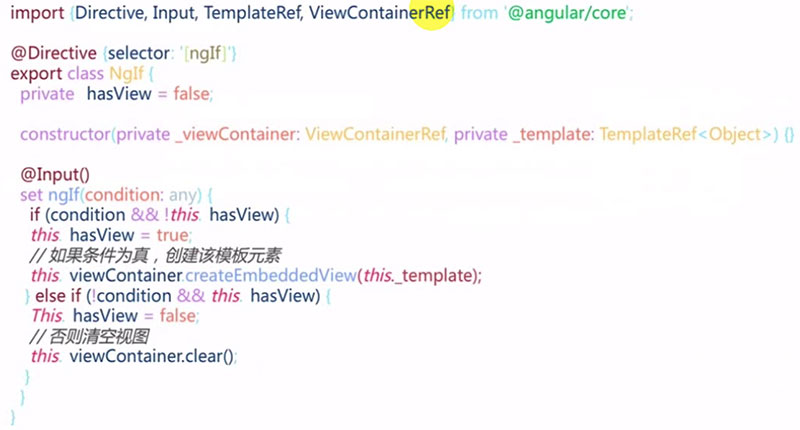жӮЁеҘҪпјҢзҷ»еҪ•еҗҺжүҚиғҪдёӢи®ўеҚ•е“ҰпјҒ
жӮЁеҘҪпјҢзҷ»еҪ•еҗҺжүҚиғҪдёӢи®ўеҚ•е“ҰпјҒ
иҝҷзҜҮж–Үз« дё»иҰҒд»Ӣз»ҚдәҶAngularз»“жһ„еһӢжҢҮд»ӨжЁЎеқ—е’Ңж ·ејҸзҡ„зӨәдҫӢеҲҶжһҗпјҢе…·жңүдёҖе®ҡеҖҹйүҙд»·еҖјпјҢж„ҹе…ҙи¶Јзҡ„жңӢеҸӢеҸҜд»ҘеҸӮиҖғдёӢпјҢеёҢжңӣеӨ§е®¶йҳ…иҜ»е®ҢиҝҷзҜҮж–Үз« д№ӢеҗҺеӨ§жңү收иҺ·пјҢдёӢйқўи®©е°Ҹзј–еёҰзқҖеӨ§е®¶дёҖиө·дәҶи§ЈдёҖдёӢгҖӮ
*жҳҜдёҖдёӘиҜӯжі•зі–,<a *ngIf="user.login">йҖҖеҮә</a>зӣёеҪ“дәҺ
<ng-template [ngIf]="user.login">
<a>йҖҖеҮә</a>
</ng-template>
йҒҝе…ҚдәҶеҶҷng-templateгҖӮ
<ng-template [ngIf]="item.reminder"> <mat-icon > alarm </mat-icon> </ng-template> <!-- <mat-icon *ngIf="item.reminder"> alarm </mat-icon> -->
з»“жһ„еһӢжҢҮд»Өдёәд»Җд№ҲиғҪж”№еҸҳз»“жһ„пјҹ
ngIfжәҗз Ғ

setж–№жі•ж Үи®°дёә@InputпјҢеҰӮжһңжқЎд»¶дёәзңҹиҖҢдё”дёҚеҗ«viewзҡ„иҜқпјҢжҠҠеҶ…йғЁhasViewж ҮиҜҶдҪҚзҪ®дёәtrue然еҗҺйҖҡиҝҮviewContainerж №жҚ®templateеҲӣе»әдёҖдёӘеӯҗviewгҖӮ
жқЎд»¶дёҚдёәзңҹе°ұз”Ёи§Ҷеӣҫе®№еҷЁжё…з©әжүҖеҗ«еҶ…е®№гҖӮ
viewContainerRefпјҡе®№еҷЁпјҢжҢҮд»ӨжүҖеңЁзҡ„и§Ҷеӣҫзҡ„е®№еҷЁ
д»Җд№ҲжҳҜжЁЎеқ—пјҹзӢ¬з«ӢеҠҹиғҪзҡ„ж–Ү件йӣҶеҗҲпјҢз”ЁжқҘз»„з»Үж–Ү件гҖӮ
жЁЎеқ—е…ғж•°жҚ®
entryComponents:иҝӣе…ҘжЁЎеқ—е°ұиҰҒз«ӢеҲ»еҠ иҪҪзҡ„пјҲжҜ”еҰӮеҜ№иҜқжЎҶпјүпјҢиҖҢдёҚжҳҜи°ғз”Ёзҡ„ж—¶еҖҷеҠ иҪҪгҖӮ
exports:жЁЎеқ—еҶ…йғЁзҡ„жғіиҰҒи®©еӨ§е®¶е…¬з”ЁпјҢдёҖе®ҡиҰҒexportеҮәжқҘгҖӮ
forRoot()жҳҜд»Җд№Ҳ?
imports: [RouterModule.forRoot(routes)],
imports: [RouterModule.forChild(route)];
е…¶е®һforRootе’ҢforChildжҳҜдёӨдёӘйқҷжҖҒе·ҘеҺӮж–№жі•гҖӮ
constructor(guard: any, router: Router); /** * Creates a module with all the router providers and directives. It also optionally sets up an * application listener to perform an initial navigation. * * Options (see `ExtraOptions`): * * `enableTracing` makes the router log all its internal events to the console. * * `useHash` enables the location strategy that uses the URL fragment instead of the history * API. * * `initialNavigation` disables the initial navigation. * * `errorHandler` provides a custom error handler. * * `preloadingStrategy` configures a preloading strategy (see `PreloadAllModules`). * * `onSameUrlNavigation` configures how the router handles navigation to the current URL. See * `ExtraOptions` for more details. * * `paramsInheritanceStrategy` defines how the router merges params, data and resolved data * from parent to child routes. */ static forRoot(routes: Routes, config?: ExtraOptions): ModuleWithProviders<RouterModule>; /** * Creates a module with all the router directives and a provider registering routes. */ static forChild(routes: Routes): ModuleWithProviders<RouterModule>; }
е…ғж•°жҚ®ж №жҚ®дёҚеҗҢжғ…еҶөдјҡеҸҳеҢ–пјҢе…ғж•°жҚ®жІЎеҠһжі•еҠЁжҖҒжҢҮе®ҡпјҢдёҚеҶҷе…ғж•°жҚ®пјҢзӣҙжҺҘжһ„йҖ дёҖдёӘйқҷжҖҒзҡ„е·ҘзЁӢж–№жі•пјҢиҝ”еӣһдёҖдёӘModuleгҖӮ
еҲӣе»әдёҖдёӘserviceModule:$ ng g m services
import { NgModule } from '@angular/core'; import { CommonModule } from '@angular/common'; @NgModule({ declarations: [], imports: [ CommonModule ] }) export class ServicesModule { }ServiceModuleйҮҢйқўзҡ„е…ғж•°жҚ®дёҚиҰҒдәҶгҖӮз”ЁдёҖдёӘйқҷжҖҒж–№жі•forRootиҝ”еӣһгҖӮ
import { NgModule, ModuleWithProviders } from '@angular/core'; import { CommonModule } from '@angular/common'; @NgModule() export class ServicesModule { static forRoot(): ModuleWithProviders{ return { ngModule: ServicesModule, providers:[] } } }еңЁcore ModuleдёӯеҜје…Ҙзҡ„ж—¶еҖҷдҪҝз”Ё
imports: [ServicesModule.forRoot();]
ngClass,ngStyleе’Ң[class.yourclass]
ngClassпјҡз”ЁдәҺжқЎд»¶еҠЁжҖҒжҢҮе®ҡж ·ејҸзұ»пјҢйҖӮеҗҲеҜ№ж ·ејҸеҒҡеӨ§йҮҸжӣҙж”№зҡ„жғ…еҶөгҖӮйў„е…Ҳе®ҡд№үеҘҪclassгҖӮ
<mat-list-item class="container" [@item]="widerPriority" [ngClass]="{ 'priority-normal':item.priority===3, 'priority-important':item.priority===2, 'priority-emergency':item.priority===1 }"ngStyleпјҡз”ЁдәҺжқЎд»¶еҠЁжҖҒжҢҮе®ҡж ·ејҸпјҢйҖӮеҗҲе°‘йҮҸжӣҙж”№зҡ„жғ…еҶөгҖӮжҜ”еҰӮдёӢйқўдҫӢеӯҗдёӯ[ngStyle]="{'order':list.order}"гҖӮkeyжҳҜдёҖдёӘеӯ—з¬ҰдёІгҖӮ
[class.yourclass] пјҡ[class.yourclass] = "condition"зӣҙжҺҘеҜ№еә”дёҖдёӘжқЎд»¶гҖӮиҝҷдёӘconditionж»Ўи¶ійҖӮеҗҲеә”з”ЁиҝҷдёӘclassгҖӮзӯүд»·дәҺngClassзҡ„еҶҷжі•пјҢзӣёеҪ“дәҺжҳҜngClassзҡ„еҸҳдҪ“пјҢз®ҖеҶҷгҖӮ
<div class="content" mat-line [class.completed]="item.completed"> <span [matTooltip]="item.desc">{{item.desc}}</span> </div>еҺҹзҗҶе°ұжҳҜеҠЁжҖҒжҢҮе®ҡflexе®№еҷЁж ·ејҸзҡ„orderдёәlistжЁЎеһӢеҜ№иұЎйҮҢзҡ„orderгҖӮ
1гҖҒеңЁtaskHomeдёӯз»ҷapp-task-listж·»еҠ order
list-containerжҳҜдёҖдёӘflexе®№еҷЁпјҢе®ғзҡ„жҺ’еҲ—йЎәеәҸжҳҜжҢүз…§orderеҺ»жҺ’еәҸзҡ„гҖӮ
<app-task-list *ngFor="let list of lists" class="list-container" app-droppable="true" [dropTags]="['task-item','task-list']" [dragEnterClass]=" 'drag-enter' " [app-draggable]="true" [dragTag]=" 'task-list' " [draggedClass]=" 'drag-start' " [dragData]="list" (dropped)="handleMove($event,list)" [ngStyle]="{'order': list.order}" >2гҖҒlistж•°жҚ®з»“жһ„йҮҢйңҖиҰҒжңүorderпјҢжүҖд»ҘеўһеҠ orderеұһжҖ§
lists = [ { id: 1, name: "еҫ…еҠһ", order: 1, tasks: [ { id: 1, desc: "д»»еҠЎдёҖпјҡ еҺ»жҳҹе·ҙе…Ӣд№°е’–е•Ў", completed: true, priority: 3, owner: { id: 1, name: "еј дёү", avatar: "avatars:svg-11" }, dueDate: new Date(), reminder: new Date() }, { id: 2, desc: "д»»еҠЎдёҖпјҡ е®ҢжҲҗиҖҒжқҝеёғзҪ®зҡ„PPTдҪңдёҡ", completed: false, priority: 2, owner: { id: 2, name: "жқҺеӣӣ", avatar: "avatars:svg-12" }, dueDate: new Date() } ] }, { id: 2, name: "иҝӣиЎҢдёӯ", order:2, tasks: [ { id: 1, desc: "д»»еҠЎдёүпјҡ йЎ№зӣ®д»Јз ҒиҜ„е®Ў", completed: false, priority: 1, owner: { id: 1, name: "зҺӢдә”", avatar: "avatars:svg-13" }, dueDate: new Date() }, { id: 2, desc: "д»»еҠЎдёҖпјҡ еҲ¶е®ҡйЎ№зӣ®и®ЎеҲ’", completed: false, priority: 2, owner: { id: 2, name: "жқҺеӣӣ", avatar: "avatars:svg-12" }, dueDate: new Date() } ] } ];3гҖҒеңЁlistжӢ–жӢҪжҚўйЎәеәҸзҡ„ж—¶еҖҷпјҢж”№еҸҳorder
дәӨжҚўдёӨдёӘsrcListе’Ңзӣ®ж Үlistзҡ„йЎәеәҸorder
handleMove(srcData,targetList){ switch (srcData.tag) { case 'task-item': console.log('handling item'); break; case 'task-list': console.log('handling list'); const srcList = srcData.data; const tempOrder = srcList.order; srcList.order = targetList.order; targetList.order = tempOrder; default: break; } }ж„ҹи°ўдҪ иғҪеӨҹи®Өзңҹйҳ…иҜ»е®ҢиҝҷзҜҮж–Үз« пјҢеёҢжңӣе°Ҹзј–еҲҶдә«зҡ„вҖңAngularз»“жһ„еһӢжҢҮд»ӨжЁЎеқ—е’Ңж ·ејҸзҡ„зӨәдҫӢеҲҶжһҗвҖқиҝҷзҜҮж–Үз« еҜ№еӨ§е®¶жңүеё®еҠ©пјҢеҗҢж—¶д№ҹеёҢжңӣеӨ§е®¶еӨҡеӨҡж”ҜжҢҒдәҝйҖҹдә‘пјҢе…іжіЁдәҝйҖҹдә‘иЎҢдёҡиө„и®Ҝйў‘йҒ“пјҢжӣҙеӨҡзӣёе…ізҹҘиҜҶзӯүзқҖдҪ жқҘеӯҰд№ !
е…ҚиҙЈеЈ°жҳҺпјҡжң¬з«ҷеҸ‘еёғзҡ„еҶ…е®№пјҲеӣҫзүҮгҖҒи§Ҷйў‘е’Ңж–Үеӯ—пјүд»ҘеҺҹеҲӣгҖҒиҪ¬иҪҪе’ҢеҲҶдә«дёәдё»пјҢж–Үз« и§ӮзӮ№дёҚд»ЈиЎЁжң¬зҪ‘з«ҷз«ӢеңәпјҢеҰӮжһңж¶үеҸҠдҫөжқғиҜ·иҒ”зі»з«ҷй•ҝйӮ®з®ұпјҡis@yisu.comиҝӣиЎҢдёҫжҠҘпјҢ并жҸҗдҫӣзӣёе…іиҜҒжҚ®пјҢдёҖз»ҸжҹҘе®һпјҢе°Ҷз«ӢеҲ»еҲ йҷӨж¶үе«ҢдҫөжқғеҶ…е®№гҖӮ